Installation Work
Collective Node, 2011, in collaboration with Jonathan Cecil
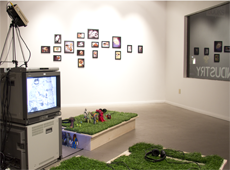
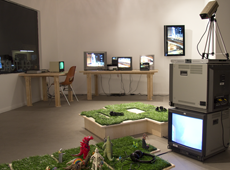
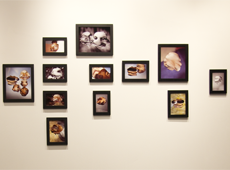
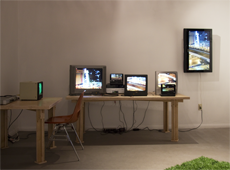
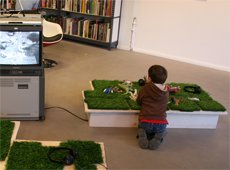
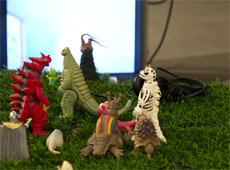
Collective Node: An Installation by Jonathan Cecil and Yumi Kinoshita
By Simon Taylor
The gallery at Left Coast Books, in Goleta, California (5877 Hollister Avenue), is pleased to announce a collaborative installation
by Jonathan Cecil and Yumi Kinoshita, titled Collective Node. Their installation has been in the planning stages for several months,
but the timing of this exhibition, on the heels of the catastrophic tsunami in Japan and an apparent meltdown of some nuclear reactors,
is uncanny because elements in Cecil and Kinoshita's exhibition address such topical issues as the ever-present dangers of nuclear technology,
our misplaced faith in "value-free" technology, and media representations of disaster capitalism.
Take, for example Dream Space, located in the center of the gallery, which consists of two large Sony monitors, one stacked on top of the
other, positioned so the screens are at a 90 degree angle. A video camera, resting on a tripod, sits on top of the monitors, and points
toward a gathering of plastic toy monsters, reminiscent of Godzilla and his kin from the world of Japanese anime. One monitor shows a live
feed of the monsters, while the other (being watched by the monsters) displays a calm, blue sky, with wisps of clouds--a tranquil scene,
perhaps, but footage shot at precisely the geographical location where the atomic bomb was dropped on Hiroshima. The plastic toys sit near
platforms astroturfed with the floor plans of the artists' childhood homes. As the artists' accompanying Statement reveals, there are additional
layers of personal and political connotation in the accompanying audio, which includes the racist radio commentator Rush Limbaugh mouthing-off
as a pseudo-Oriental (Japan and China are all the same to him, he declares).
If Dream Space and a collection of deformed and mutant (digitally-manipulated) Family Portraits (shown on an adjacent wall) express our fears
of technology, but in a playful and dark-humored way, there is something more poignant about the silent urban landscape represented by Six Ueno
Stations, both in what is represented and how it is represented, with its array of recent and obsolete video monitors and screens. In the whole
ensemble, there are two laptop computers and a large-screen plasma tv that appear to be quite current, but some of the monitors date back to the
eighties and even earlier, and it shows not only in their clunky, oversized appearance, but in the way a similar scene of video footage, showing
the Ueno Station, a big transportation hub in Tokyo, looks when mediated by different technologies, how vision and cognition are determined,
in part, by technology.
The scene at Ueno Station is a crazy urban collage of trains, cars, and the occasional pedestrian, walking at a pace that seems unbearably slow
compared to the speed of the surrounding environment. The imagery is intriguing to watch and the spectator is quickly seduced by the voyeuristic
role of the camera. The viewer anticipates something might happen, but the street scenes are on a loop; there's no beginning, middle, or end,
like Warhol's Empire. There is some symbolism, however, in the choice of location. Critically, it helps to know that the footage in Six Ueno
Stations was shot, as the artists have written, "from a hotel window across from the Ueno Station in Tokyo, which was a striving neighborhood
in the 1970s, now struggling to be commercially and culturally relevant in the 21st century global economy." After the lost decade of the nineties,
the recent recall of madly-accelerating Toyotas, the tsunami and unfolding nuclear disaster, it appears that Japan itself is in meltdown, that
the Six Ueno Stations could be taken for a metaphor of the nation writ large, of one that is lost, or adrift. Or perhaps the artists are simply
pointing to the anomie of urban existence. It is hard to say.
Of course, it's not just Japan that's in meltdown; it's the entire planet, which we continue to exploit and pollute. Soon after the tsunami hit
Japan, communities up and down the California coast were placed on alert, especially in places like Port San Luis, just north of here, where
there is a nuclear facility near the water, in an earthquake zone--a disaster just waiting to happen. Perhaps this exhibition can be a
consciousness-raising opportunity to the dangers, real and imagined, lurking in our own backyard.